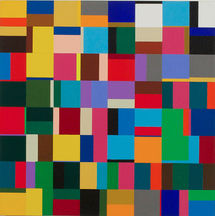Knut Navrot
Primary colours - Blue (limits)
Setting:
Let there be, within a square, a limit between the blue and one of the two other primary colours.
The blue may be either at the top or on the left. This limit may be either vertical or horizontal.
All visually distinct limits within a 3 cm square will be considered: that is, 49 limits.
The resulting arrangement of the 196 limits obtained will be random and considered as a possible occurrence.
The setting will exhaust all possible arrangements.
Primary colours - Limits
Setting:
Let there be, within a square, a limit between the blue and the red, the blue and the yellow, the red and the yellow. This limit may be either vertical or horizontal.
All visually distinct limits within a 3 cm square will be considered: that is, 49 limits.
The resulting arrangement of the 588 limits obtained will be random and considered as a possible occurrence.
The setting will exhaust all possible arrangements.
Random colours - Blue (limits)
Setting:
Let there be, within a square, a limit between the blue and a colour randomly selected from a given colour chart. This limit may be either vertical or horizontal.
All visually distinct limits within a 3 cm square will be considered: that is, 49 limits.
The resulting arrangement of the 4,116 limits obtained will be random and considered as a possible occurrence.
The setting will exhaust all possible arrangements.
Random colours - Limits
Setting:
Let there be, within a square, a limit between two colours randomly selected from a given colour chart. This limit may be either vertical or horizontal.
All visually distinct limits within a 3 cm square will be considered: that is, 49 limits.
The resulting arrangement of the 168,756 limits obtained will be random and considered as a possible occurrence.
The setting will exhaust all possible arrangements.
Black (limits)
Setting:
Let there be, within a square, a limit between the black and the white. The black may be either at the top or at the bottom, on the left or on the right. This limit may therefore be vertical or horizontal.
All visually distinct limits within a 3 cm square will be considered: that is, 49 limits.
The resulting arrangement of the 196 limits obtained will be random and considered as a possible occurrence.
The setting will exhaust all possible arrangements.
Non-orthogonal limit
Setting:
Let there be, within a 15 cm square, a non-orthogonal limit between two colours randomly selected from a given colour chart. The square may assume one of four possible positions, the order of these being chosen at random and considered as a possible occurrence. Each occurrence will introduce a new colour and will conform to the same process.
The setting will exhaust all possible arrangements.
Passage from primary colors to random colours by addition - Blue (limit)
Setting:
Let there be, within a square, a central limit between the blue and the red, the blue and the yellow. This limit may be either vertical or horizontal.
One colour, randomly selected from a given colour chart, will successively be added to the process, giving rise to limits between the blue and these additional colours. These limits themselves may be either horizontal or vertical.
The setting will exhaust all the colours of the said colour chart.
Passage from primary colours to random colours by addition - Limits
Setting:
Let there be a limit, randomly selected from the 49 visually distinct limits within a 3 cm square, respectively between the blue and the red, the blue and the yellow, the red and the yellow. The limit may be vertical and horizontal.
The arrangement of these 12 limits will be random.
With each new arrangement, a new colour will be introduced, randomly selected from a given colour chart, and combined with the previous colours in the same way.
The resulting limits will be arranged randomly each time.
The setting will exhaust all the colours of the said colour chart.
An attempt at exhausting the possible moves on a limited surface
Setting:
Let there be, on a surface, a network of 49 points geometrically structured in a square.
A line will randomly connect the points without ever overlapping, thus constituting a possible move.
The setting will exhaust all possible occurrences.






















